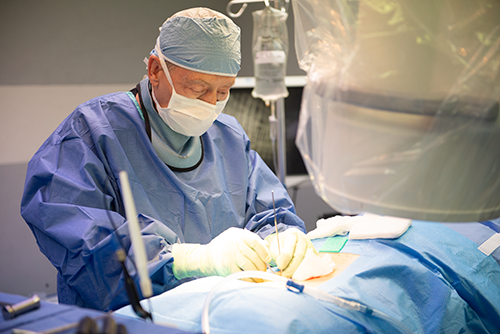Lumbar spinal stenosis due to degenerative spondylolisthesis is a widespread condition and has become one of the most common indications for spinal surgery. In the United States over 95% of patients with degenerative spondylolisthesis requiring surgery now undergo a decompression with fusion regardless of the severity of the spondylolisthesis. Spinal Fusion became the “gold standard” for the treatment of mechanical low back pain, yet there was no scientific basis for it. According to an article published in the Journal of Spinal Surgery, posterior decompression surgery should be the gold standard for lumbar stenosis without instability and deformity. Spinal decompression surgery addresses the stenosis and avoids the risks and complications associated with spinal fusion surgeries. The Bonati Spine Procedures correct the stenosis by decompressing the neural structures, which alleviate the symptoms, and return patients to their normal activities within days of their procedures, without having to resort to spinal fusions.
Treatment Of Spinal Stenosis Caused by Degenerative Spondylolisthesis
Symptoms of lumbar spinal stenosis due to degenerative spondylolisthesis originate from either compression of the Dural sac or the nerve roots. These conditions are treated by performing a decompression of the neural structures; however many surgeons also perform an instrumented spinal fusion for spinal stenosis caused by degenerative spondylolisthesis regardless of the degree of spondylolisthesis. Up to 95% of patients with grade 1 spondylolisthesis that suffer from spinal stenosis symptoms such as radicular pain, weakness, or numbness are treated with decompression plus stabilization (instrumented spinal fusions). Spinal fusions however are much more invasive, damage the surrounding tissues, have higher risks, longer recovery times, and in the long term may lead to a condition known as Adjacent Segment Disease (ASD). This is where the levels above and below the fusion develop spinal stenosis and may lead to additional fusions in the future.
An Epidemic of Fusions
According to a study published in Clinicalspinesurgery.com, in 2007 in the United States, decompression surgery was performed 20.6% of the time, whereas instrumented operations were performed in 79.4% of the patients. Although decompression alone was suggested for the treatment of low grade (<20%) degenerative spondylolisthesis in the clinical guidelines of the North American Spine Society, in the United States over 95% of patients with degenerative spondylolisthesis requiring surgery now undergo a decompression with fusion regardless of the severity of the spondylolisthesis. In fact, decompression with fusion surgery has become the standard treatment for degenerative spondylolisthesis, despite not being able to provide better results than decompression alone in pain-related disorders, spine dysfunction, walking ability, social dysfunction and psychological disorders. Furthermore, instrumented spinal fusions have more risks compared to decompression alone because of more blood loss, longer operative time, pedicle screw-related complications such as misplacement of the screw, nonunion, and future adjacent segment disease resulting in spinal stenosis on adjacent levels. In fact, a prospective study for isthmic spondylolisthesis showed that the risk of additional surgery on the lumbar spine was markedly higher when the fusion was performed with instrumentation.
Studies Comparing Decompression Surgery Vs. Decompression And Fusion
The symptoms of lumbar spinal stenosis originate from compression of the dural sac or nerve root, therefore there is a need to decompress the neural structures to get rid of the symptoms. Studies have shown that degenerative spondylolisthesis patients with spinal stenosis that undergo surgical treatment show significantly more improvement than patients who are treated non-surgically. However, most people who have spinal stenosis due to degenerative spondylolisthesis undergo a spinal fusion instead of a decompression spinal surgery alone despite the associated risks. In a Prospective, Randomized Study published by Hiroyuki Inose, MD and Tsuyoshi Kato, MD. Et al, they concluded that additional instrumentation operation for low-grade degenerative spondylolisthesis did not result in superior results to decompression alone at 1 and 5 years postoperatively. According to Pasquale Donnarumma, Roberto Tarantino, et al, concluded that “Our study supports posterior decompression alone as the gold standard option as treatment for lumbar stenosis without instability and deformity. Additional fusion should be considered only to prevent post-surgical instability. The “micro-instability” is a radiological finding that has its clinical surrogate but is not able to guide the choice of the type of surgery. Moreover, the significance of “micro-instability” is still unclear “ in their study Decompression versus decompression and fusion for degenerative lumbar stenosis: analysis of the factors influencing the outcome of back pain and disability.
The Bonati Spine Procedures Vs. Spinal Fusions
The Bonati Spine Procedures provide state of the art solutions to Spinal Stenosis due to degenerative spondylolisthesis by decompressing the neural structures affected by the stenosis thus relieving the associated symptoms. They obtain better results than spinal fusions, with a shorter recovery time, while avoiding the chance of adjacent segment disease. The Bonati Spine Institute surgeons can successfully relieve the pain associated with spinal stenosis and get patients back to their daily activities within days of their procedures. The Bonati Spine procedures have been performed successfully over 75,000 times while obtaining a patient reported satisfaction rate of 98.78%.

